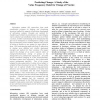352 search results - page 66 / 71 » The Structure of First-Order Causality |
IJMMS
1998
13 years 8 months ago
1998
Clancey (1992) proposed the model-construction framework as a way to explain the reasoning of knowledge-based systems (KBSs), based on his realization that all KBSs construct impl...
HICSS
2009
IEEE
14 years 3 months ago
2009
IEEE
Information systems (IS) researchers have made considerable progress on defining and formalizing structured methods to support collaborative development of information systems. Co...
BMCBI
2010
13 years 8 months ago
2010
Background: Biological networks offer us a new way to investigate the interactions among different components and address the biological system as a whole. In this paper, a revers...
BMCBI
2010
13 years 8 months ago
2010
Background: Haplotype-based approaches have been extensively studied for case-control association mapping in recent years. It has been shown that haplotype methods can provide mor...
PLPV
2012
ACM
12 years 4 months ago
2012
ACM
Functional Reactive Programming (FRP) is a form of reactive programming whose model is pure functions over signals. FRP is often expressed in terms of arrows with loops, which is ...

